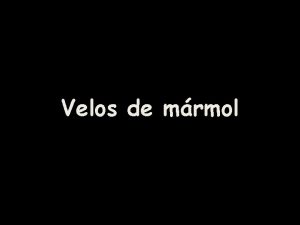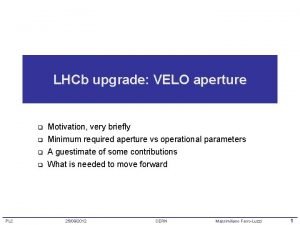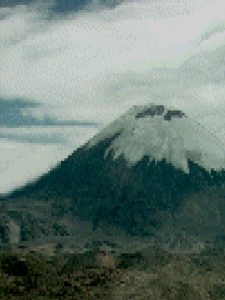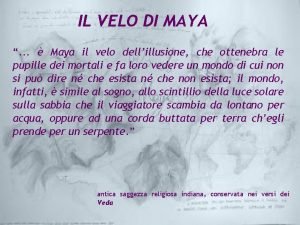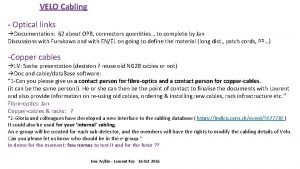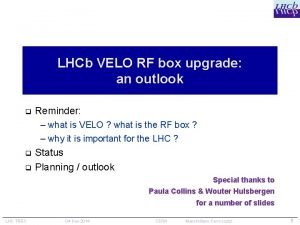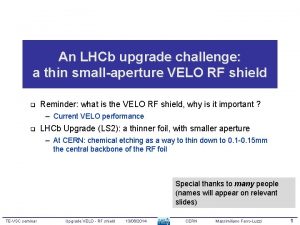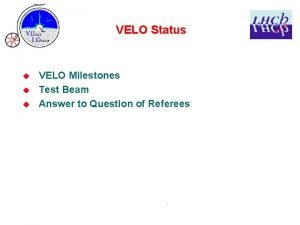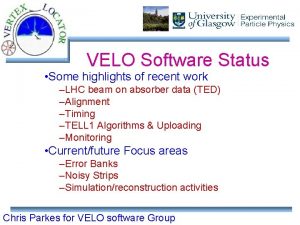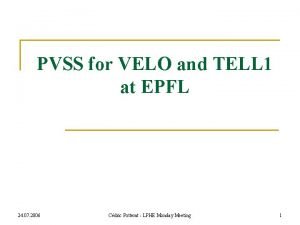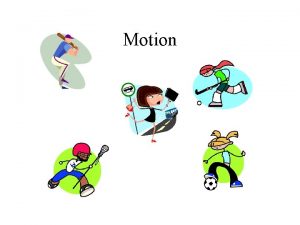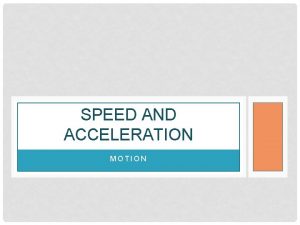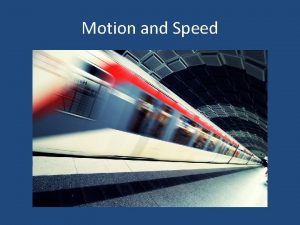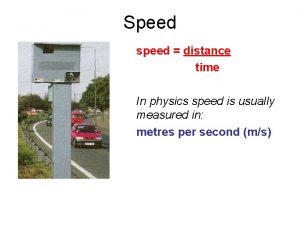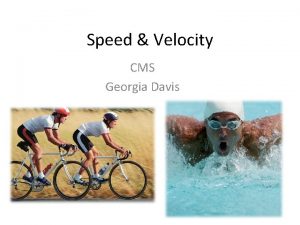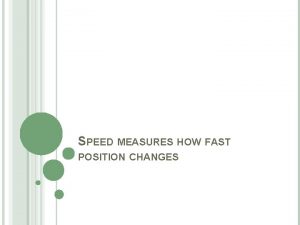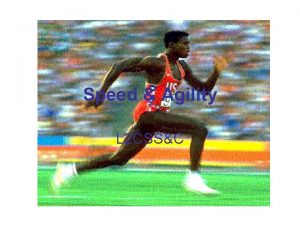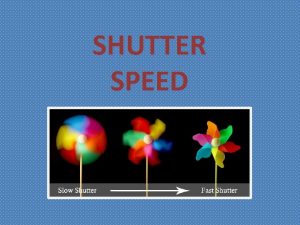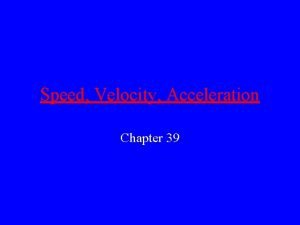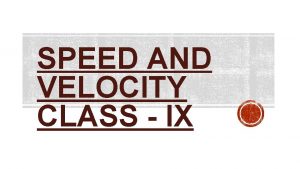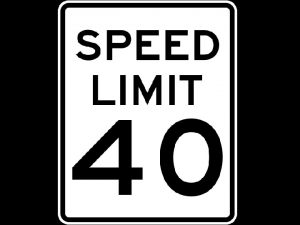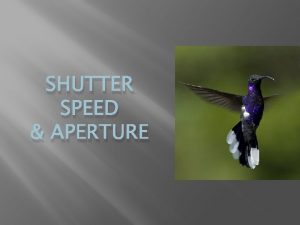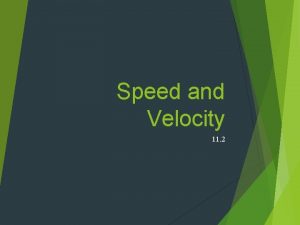Speed Velo Linear Motion Linear motion motion in

































- Slides: 33

Speed & Velo

Linear Motion Linear motion: motion in a single dimension v. Moving in a straight line v. Ex: riding in a car without your hands on the steering wheel v. Non-ex: making a turn around a corner

Rates Rate: A quantity divided by time v. A rate tells how quickly something happens vmiles per hour, words per minute, meters per second v. Ex: speed (meters per second), acceleration (meters per second) v. Non-ex: distance (meters), time (seconds)

Motion is Relative Frame of Reference: point of view of the observer v. If something is relative, it depends on the frame of reference. v. Usually, when we discuss the speeds of things on Earth, we mean the speed with respect to the Earth’s surface.

Speed v Speed is a measure of how fast something is moving. vthe rate at which distance is covered. Speed: the distance covered per unit of time. v. SI unit: m/s v. Ex: 100 km/hr, 55 mph, 30 m/s v. Equation: v = d / t vv = speed (m/s) vd = distance (m) vt = time (s)

Types of Speed v. Instantaneous speed vthe speed at any given instant v. Ex: speedometer; radar gun v. Average speed vthe total distance covered divided by the time v. Average speed does not indicate changes in the speed that may take place during a trip. v. BOTH instantaneous and average speeds indicate the rate at which distance is covered.

Physics Problem Solving Strategy 1. List your variables 1. Givens 2. Unknown variable 2. If need be, convert variables to SI units 3. Choose the equation that matches your variables 4. Substitute variables in to the equation 5. Solve

Check Your Understanding If a cheetah can maintain a constant speed of 25 m/s, it covers 25 meters every second. At this rate, how far will it travel in 10 seconds? üd = ? v = 25 m/s t = 10 s v = d /t 25 m/s = (d) / (10 s) d = (25 m/s)(10 s) d = 250 m

Check Your Understanding How about in one minute? üd = ? v = 25 m/s t = 60 s **Convert minutes seconds** v=d/t 25 m/s = (d) / (60 s) d = (25 m/s)(60 s) d = 1500 m

Velocity: the speed in a given direction v. SI unit: m/s v. Ex: 100 km/hr East, 55 mph North, 30 m/s Southwest v. Equation: v=d/t vv = velocity (m/s) vd = distance (m) vt = time (s)

Speed vs Velocity v. When we say that a car travels 60 km/hr, we are indicating its speed. When we say that a car is traveling 60 km/hr to the north, we are indicating its velocity. v. Speed is a description of how fast an object moves; velocity is how fast it moves AND in what direction.

Check Your Understanding The speedometer of a car moving northward reads 100 km/h. It passes another car that travels southward at 100 km/h. Do both have the same speed? Do they have the same velocity? ü Both cars have the same speed, but they have opposite velocities because they are moving in opposite directions.

Types of Velocity v. Constant Velocity vrequires both constant speed and constant direction (moving in a straight line)

Types of Velocity v. Changing Velocity v 3 ways to change velocity v. Increase speed v. Decrease speed v. Change direction v. Constant speed and constant velocity are NOT the same thing. v. Ex: A body may move with constant speed around a curved path, but it does not move with constant velocity b/c the direction changes at every instant.

Scalar Quantities Scalar: a quantity that requires magnitude only v. Number and units ONLY; no direction v. Ex: Speed, mass, time v. Non-ex: Velocity

Vector Quantities Vector: a quantity that requires both magnitude AND direction v. Number, units, AND direction v. Ex: Velocity, acceleration, force v. Non-ex: Speed, temperature

Check Your Understanding Is height a vector or a scalar quantity? ü Scalar. Height only includes magnitude (how big the number is) only and NOT direction. You are 5’ 8” tall, not 5’ 8” to the east.

Vector Quantities v. An arrow is used to represent the magnitude & direction of a vector quantity. v. The length of the arrow indicates the magnitude (size) of the vector quantity. v. The direction of the arrow represents the direction of the vector quantity. 10 m to the right 50 m to the left

Adding Vectors v. When more than one vector combines together, both the magnitude AND the direction matter. v. The sum of 2 or more vectors is called the resultant.

Adding Vectors v Arrows both point in the same direction v added together to find the resultant v Ex: 4 m/s E + 3 m/s E = 7 m/s E 4 m/s East + 3 m/s East = 7 m/s East

Adding Vectors v Arrows point in opposite directions v subtracted to find the resultant v Ex: 4 m/s E – 3 m/s W = 1 m/s E 4 m/s East + 3 m/s West = 1 m/s East

Adding Vectors v When arrows are not in one dimension v Draw the arrows tip to tail v v The tail of the first arrow should be at the origin (at the beginning) Place the tail of the next arrow at the tip of the first v The straight line from the tail of the first arrow to the tip of the last arrow is the resultant vector + = =

Example 1 = + =

Example 2 + + = =

Example 3 + + + =

Check Your Understanding A boy is riding his bike down the street at a speed of 10 m/s. A gust of wind came out of nowhere headed towards the boy. If the wind is traveling 3 m/s, what will the boy’s new speed be? ü Since the boy and the wind are moving in opposite directions, we need to subtract their speeds to find the resultant. 10 m/s – 3 m/s = 7 m/s

Position Time Graphs v Position Time graphs show the distance covered over an elapsed time v. Aka Distance Time graphs and Displacement Time graphs v. Time is always the independent variable v. Position (distance) is always the dependent variable

Position Time Graphs v The slope of a Position. Time graph is equal to velocity v. Slope = rise / run v. Slope = position / time v. Velocity = position / time

Position Time Graphs v Slope of a position-time graph v. The steeper the slope, the faster the velocity v. A positive slope is forward motion v. A negative slope is moving backwards v. A zero slope is NOT moving at all


Check Your Understanding Which person is moving faster, the red or blue jogger? ü The red jogger’s line has a steeper slope and therefore a faster speed.

Check Your Understanding Are both joggers moving forwards or backwards? ü Forwards. The slope is positive, so the distance increases as the time increases.

Check Your Understanding At what time does Person B pass Person A? ü At 45 seconds. The lines intersect at this time and both runners are at the same position at the same time.
 How to find speed with distance and time
How to find speed with distance and time A narrow field of vision (140 degrees or less) is called
A narrow field of vision (140 degrees or less) is called Speed detection of moving vehicle using speed cameras
Speed detection of moving vehicle using speed cameras Bernini escultura velo
Bernini escultura velo Velo locator
Velo locator Sindromul velo-cardio-facial
Sindromul velo-cardio-facial Motivation velo
Motivation velo La piedra feliz leyenda
La piedra feliz leyenda Ruota di issione schopenhauer
Ruota di issione schopenhauer Schopenhauer velo di maya
Schopenhauer velo di maya Agrément accompagnateur vélo
Agrément accompagnateur vélo Zone de schroeder
Zone de schroeder Conductos nutricios dentales
Conductos nutricios dentales Velo documentation
Velo documentation Membrana tectoria cervelletto
Membrana tectoria cervelletto El velo se rasgo versiculo
El velo se rasgo versiculo Outlookq
Outlookq Aponeurosis palatina
Aponeurosis palatina Velo
Velo Velo chip
Velo chip Lo yanum velo yishan
Lo yanum velo yishan Tes velo
Tes velo Velo trex
Velo trex Velo trex
Velo trex Picasso selle de velo
Picasso selle de velo Correr el velo
Correr el velo Peter hinnen mir sind mit em velo da
Peter hinnen mir sind mit em velo da Investigator photos
Investigator photos Velo view
Velo view Velo software
Velo software Pix
Pix Hero quested for the golden fleece
Hero quested for the golden fleece Point velo epfl
Point velo epfl Taille velo adulte
Taille velo adulte



